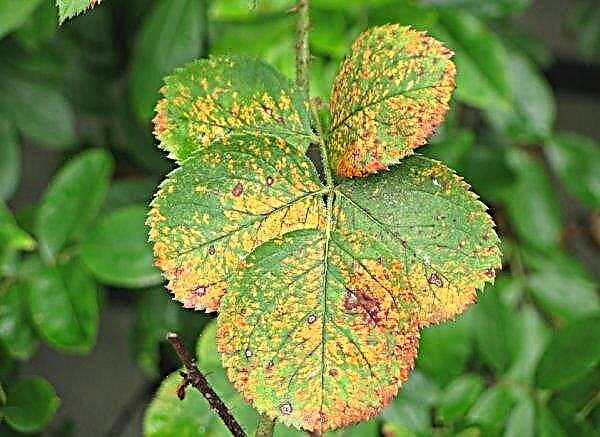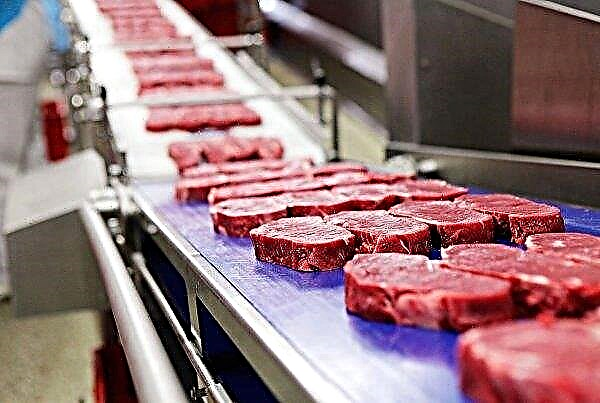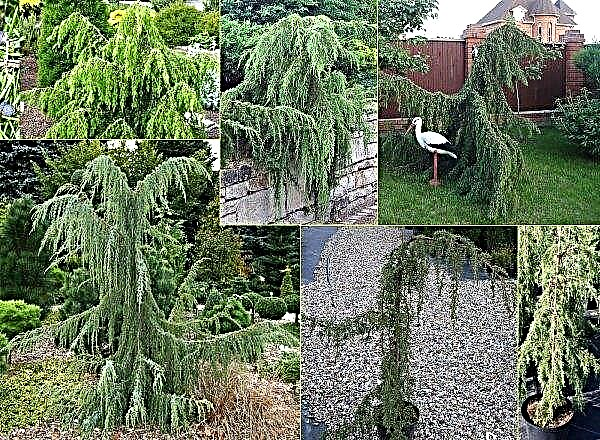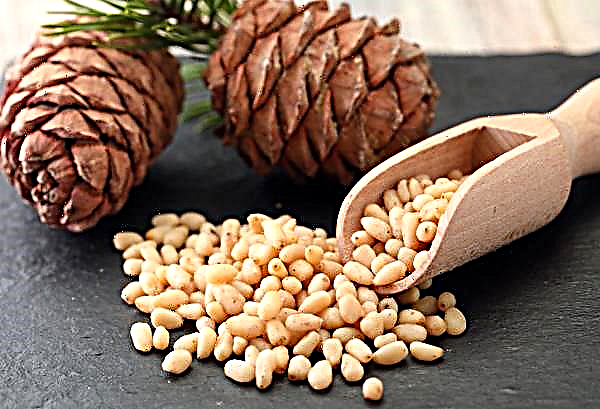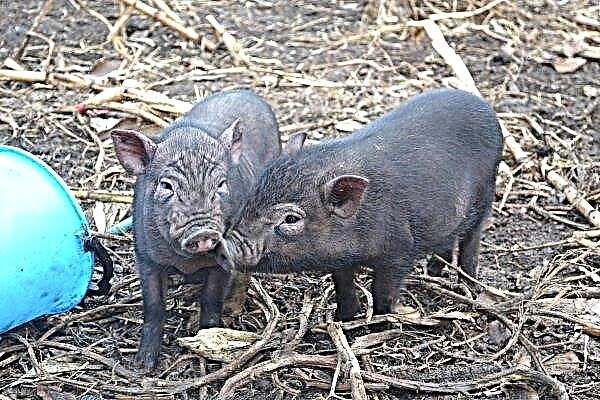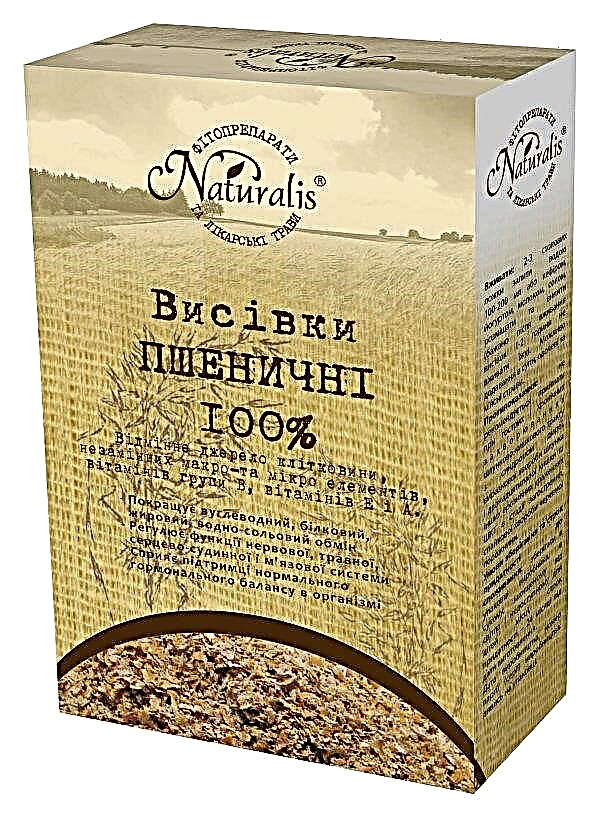With the arrival of spring warmth, work is added not only to gardeners or gardeners, but also to apiary owners, since after wintering the bees need complete preparation for the new season. What events the spring work of the beekeepers consist of, and what you should know about the main subtleties of each individual task - read on.
Spring phased work in the apiary
First of all, in the spring, it is worth putting the hives out of the winter hut, paying attention to the nature of the first flight of bees, devoting time to cleaning the hives and fixing weak nests, which will require considerable knowledge from the beekeeper.
Did you know? To get one spoonful of honey, 200 bees must work all day, flying around 12 hectares of area with honey plants.
Winter Hive Exhibition
Before exhibiting hives on the site, it is important to clear the snow and prepare the areaby sprinkling ash on cleaned soil or by spreading pieces of roofing material for faster ice melting. If only one family is planned to be removed, then the area of the cultivated area may be smaller, while when several bee houses are removed at once, a significant part of the yard will have to be removed.
The list of other preparatory measures includes:
- checking and adjusting stands for hives (they should be set with a slight slope forward);
- preparation of slate or wooden boards, which will be placed in front of the hives;
- covering the surface of the soil with a layer of straw or sawdust, so that after a short flight even sleepy insects do not sit on cold ground.

It is better to carry out bee colonies from the winter-house in the morning, so that closer to dinner all the bees are in the fresh air. Thus, the first cleaning flight will occur in the warmest part of the day.
There are several general rules for hive removal:
- Before the procedure, all the doors must be well closed;
- placement of the bee house on a stretcher or other device for its transportation is carried out a year ago;
- when moving the product, it is necessary to minimize shaking so as not to disturb insects once again;
- on the site, it is worthwhile to place a container with water in advance so that after departure all insects flock to it;
- it is only possible to open the summers after the last hive has been taken out, and the bees inside it will stop buzzing;
- with a dense arrangement of bee houses, it is better to open the doors through one, so that during the cleansing fly-insects do not wander around the territory.

The first flight of bees on the street
Having released the bees on the first flyby of the territory, the beekeepers carefully monitor each family, recording in a special journal all the features of their behavior: for example, speed and coherence of the flight, cleaning of death. Active families are considered normal and do not require increased attention from the beekeeper. The owner should be guarded by the movement of insects along the notch or the absence of a uterus in the family. If after a light tapping on the hive’s hull the buzz inside has intensified, open the doors as wide as possible so that the bees can feel the heat outside. In some situations, you can even remove the hive cover and remove the insulating layer, providing a more complete penetration of heat inside. After that, representatives of healthy families should definitely fly out of their shelter.
Some beekeepers organize the first flight of insects in greenhouse conditions, moreover, in late February or early March, the main thing is that the temperature in the shelter reaches + 30 ° С. At the end of the flight, the hives with bee families are either returned to the winter house or left at the point.
A quick tour of the bees
Approximately two hours after the end of the mass flyby by insects, the fenders in the hives need to be reduced to 1 cm, and you can immediately proceed to a quick examination of the bees. The results of such a check will determine all further actions of the beekeeper: removal of death (dead insects), replacement of moldy honeycombs, the addition of frames with food, reduction and warming of bee nests. At the end of the inspection procedure, there should be as many frames in the hive as there will be enough for the bees to heat the hive properly and optimally develop their brood.
With a partial cursory examination of families, the frames can not be removed from the hive, but only slightly extended, performing the procedure even at average temperatures within + 10 ° С. It is good if in the spring in one hive there will be at least 8-12 kg of honey, because with a reduced amount of food, bees will begin to save honey reserves to the detriment of brood.
The easiest way to carry out inspection in multihull hives, when the wintering of insects occurs immediately in two compartments. In this case, with the advent of spring, families move to the upper building, and the entire work of the beekeeper is reduced to removing the lower compartment and a quick assessment of the upper nest, in particular, and determining the amount of food for bees.
In the absence of testicles in the cells and other signs of the absence of the uterus in the family, it is worth attaching a nucleus to the uterus to it. In the first days after the exhibition from the winter house, most bees lose their sense of individuality, so family unification can be performed without any precautions.Important! If the family does not completely move to the upper section, then the insects are left at once in two compartments of their house.
Expansion and narrowing of nests
Narrowing of bee nests is practiced with the aim of facilitating the process of brood heating by insects and maintaining optimal temperature values inside the hive. To do this, you need to narrow the streets as much as possible, up to 9 mm, instead of the standard 12 mm. In addition, they remove from the bee house all the frames that until then had not been hardened by bees, found to be damaged by rodents or affected by mold. It is also necessary to extract specimens with a large number of drone eggs.
Expansion of nests is practiced in connection with an increase in the number of broods, due to which the insect becomes crowded on the existing frames. To correct the situation, their additional amount will help, immediately with honeycombs for laying eggs and placing collected nectar. Starting from the first spring revision and during the subsequent warm months, the beekeeper must constantly monitor the development of the bee family and, if necessary, expand the nests by adding frames. In case of untimely completion of the procedure, family growth will begin to slow down.
The frames used to expand the hives should always have a light brown even color and not include drone cells. The ideal option is products in which several brood generations have been bred, and it is advisable to add them at once in two pieces, placing them on two sides of the current brood.
Insulation nests
A strong family with the appearance of a brood is able to maintain the optimum temperature inside the hive, not allowing the values to fall below + 33 ... + 35 ° С. Even a slight deviation from these norms (for example, up to + 32 ° C) threatens to delay the development of brood and reduce the quality of young animals. To prevent death and save the bees from mass death (often occurs already at + 28.2 ... + 28.6 ° C), their nests are insulated by laying 8-10 layers of old newspapers or a plastic film instead of a canvas in each hive. An alternative to such materials can be any others used in construction for warming a human home.
In the early spring, it is better to completely close the lower let, leaving only the upper open. By blocking it with their bodies, the bees significantly reduce the heat loss of the entire nest, while they do not heat the bottom hole in any way, and at night you will not notice a single bee in such a notch, and cold air will easily enter the bee house. The optimal time for opening the lower hole is mid-May, immediately after you notice a large accumulation of insects in the upper notch.
Often, in order to maintain heat, beekeepers use the method of A. G. Blinov, which provides for spring restriction of brood in the nest. At the first examination of bees, the author separated young individuals from both sides of the diaphragm, and so that the feeding frames remained behind them. In this case, the nest was collected in the middle of the hive: if insects occupy about 8–9 frames, the nesting place should fall on 4 frames, with 6–7 frames occupied, on 3 frames, and the rest remain behind the diaphragms. The upper part of the hive is thoroughly insulated and remains in this state until the end of May. After this, the nests expand daily by one frame, while feeding the bees with sugar syrup (stimulates the laying of eggs in the queens).
Spring-cleaning
General cleaning of bee houses is another mandatory task for spring care for the apiary. The health and vitality of bees depends on the cleanliness of the bottoms and walls of the hive itself, and hence the final yield of honey. Of course, each option has its own characteristics, which are worth knowing before they are completed.
Donji cleaning
Cleaning of bottoms is carried out on the day of a cursory inspection of departing bee families. In extreme cases, the procedure can be postponed until the next day, but still not worth delaying. During the winter, a significant amount of dead wood and wax grains are collected in the hives, which appear when honey cells print out by bees. A large amount of death at the bottom of the bee house indicates an unsuccessful wintering of insects, and if the corpses of bees are not timely removed, then the rest of the surviving individuals may suffer from diseases and a heavy smell associated with the decomposition of the bodies of dead insects.
Video: beekeeping, first revision. Donji cleaning
In beehives with removable bottoms, cleaning is easy:
- To get started, let the club smoke in the summer.
- Then remove the hive cover, and behind it - the bee house building, after removing it from the bottom.
- In place of the seized contaminated bottom, it is worthwhile to install a spare clean one, and then return the hive itself.
- The seized contaminated bottom is cleaned above the basin, scraping well with a chisel and washing the surface with soapy water.
Important! You should not throw out the extracted "garbage" immediately after cleaning the bee house. It is more reasonable to sift the scum through a medium sieve and separate the wax grains, which are subsequently successfully reheated on a solar wax refinery.
Cleaning whole hives is somewhat more complicated and depends on the design features of each individual product. So, if there is an empty space near the nest, the scum can be scooped up in an empty place using a cob for this, and from there it can be removed using a small scoop. In the absence of such an opportunity, dead individuals are removed through the taphole, but then it is impossible to talk about complete cleaning measures and they will have to be completed with the general sanitary treatment of the hives.
Relocation and disinfection
At the end of cleaning, it remains only to treat the surface of the hive with hot ash liquor or wipe with a piece of cloth previously moistened in formalin solution (5%). Sometimes a blowtorch comes to the aid of a beekeeper, with the fire of which all walls are burned.
Compared to ordinary scrubbing, bee house disinfection always provides for the absence of insects inside the product, therefore, before starting the procedure, you will have to remove the “house” from the stand and carefully place it in the back of it, and put in the same place another clean and warm hive with sunbeams, with several frames inside. After that, in the summer of the removed hive, you need to run 2-3 clubs of smoke and, having removed the roof, remove all the insulation pads. The diaphragm is moved away from the nest by the apiary chisel, and then the bees are shaken from it into a new hive and the product is moved to a temporary box. This can be done with moldy and crystallized frames and a second diaphragm. Within the framework of high-quality honey, only wooden areas are to be cleaned, the plaque from which can be scraped off with a chisel with further disinfection of the surface with food vinegar. 
Moving the feed frame into clean hives, at the same time determine the existing bee diseases, the quantity and quality characteristics of honey, the state of brood and uterus. As for the latter, it deserves increased attention, and should not remain in the old hive. After releasing the polluted house, you need to inspect it again and sweep all the remaining bees into a scoop, to later pour it into a new hive. After making sure that the product is empty, it's time to start large-scale cleaning activities and disinfection of the hive.
Fix weak sockets
During the spring inspection of bee nests, it is quite possible to find weak insect families, which, for further development, will undoubtedly need the help of a beekeeper. The specific actions depend on the nature of the problem, so you should always be aware of several methods.
Helping Weakened Families
Weakened bee colonies will be clearly visible a month after the first spring departure, when young individuals will replace those that have already survived the winter. In a weak family, there may be 4–5 frames with bees, and to expand it, apply a light brown honeycomb, slightly sprinkled with water. As soon as the uterus lays eggs in a new place, the honeycombs are rearranged into a hive with "strong" insects, and an empty light brown honeycomb is again placed in its place, which is necessary for further egg laying.
Replacement of open brood frames by moving them from a weak bee colony to a strong one is carried out about 4–5 times in the spring, as a result of which well-developed individuals from the latter breed existing larvae and do not start swarming. At the same time, the uterus from a weak family increases its egg production, and its entire brood as a result is in the most favorable growing conditions.
A few weeks after the start of the egg laying process, brood honeycombs are again placed in a hive with a weak bee family, which is why it is amplified by a printed brood. The colony replenished with new individuals not only fully provides itself with honey reserves for the winter, but also allows you to get a lot of marketable products.
For this correction of weakened families, a prerequisite is the presence of a healthy fertile uterus, the egg production of which is restrained only by weakened relatives. If she spent a lot of energy during the winter, then she will have to find another uterus.
General care for the bee family provides for the following actions:
- insect nest restriction;
- reduction in the number of streets;
- insulation of hives for better thermoregulation;
- replenishment of feed mixtures in weakened bee families;
- feeding all bees with a mixture of honey and bee bread.
Did you know? Bees have very poor eyesight, so they can hardly distinguish objects located one and a half meters away from them. A better developed sense of smell helps them navigate better in space.
Few bees
The fewer members per one bee family, the more work the others do, which means more food is spent on maintaining the strength of the insects. Reinforcing a small family with new individuals is the best way to grow an apiary, therefore, having figured out why the previous bees died, it will be possible to move on to increasing the number of families.
In the case when a disease became a cause of a massive pestilence of bees (the presence of a problem can be determined by the spots of feces on the frame and in the letka), all contaminated honeycombs must be replaced, clean and disinfect the hive and improve the conditions for keeping insects (for example, insulate a bee house, replenish honey for insects, temporarily close the doors from a strong gust of wind).
Once a weak family has five brood frames, you can add flying bees to it by simply swapping hives (“strong” and “weak”).About 30–35 days are spent on a complete renewal of a bee family, which means that with timely updating and the correct implementation of all further actions, already in the summer weak and strong families can become equal in their development.
Low brood
The reason for the insufficient number of brood can be one of the following phenomena:
- lack of free cells for egg laying;
- temperature lower or higher than optimal values at + 34 ... + 35 ° C;
- few nurse bees for the uterus and for the larvae themselves;
- insufficient food to feed future offspring.
Correction of all possible inaccuracies in care significantly increases the chances of an increase in brood. Moreover, as soon as a strong family has more than 6 frames, replacing one of them with an empty one is even useful, which reduces the likelihood of swarming in a bee family. At the same time, only one frame should be added to the hive at a time, otherwise working insects and food may not be enough to grow offspring.
When increasing the brood by installing additional frames, it is worth adhering to a few simple rules: it is advisable to place additional frames only in the middle of the hive, and perform this procedure in calm, dry and sunny weather (or in a warm building).
Another option to increase brood numbers is to exchange available filled frames between strong and weak bees., and the latter take one frame more than they put in return. Thus, the bees will be able to more densely fill the streets and quickly start growing young animals. Empty spaces on the combs will soon be filled with representatives of a well-developed family.
Bezmatochny family
The absence of a uterus in a particular family is the biggest problem for the beekeeper, especially if there is only one in the apiary.
This phenomenon can be explained by several reasons, for example:
- severe diarrhea or other health problems;
- high activity of rodents;
- dampness in the hive;
- unsuccessful transfer of hives or loss of the uterus as a result of careless relocation of insects to another place.

Often old individuals die, because young ones are always distinguished by increased resistance to adverse environmental factors. If the former uterus died in winter or early spring, then the remaining bees will not be able to grow a new one, since there are no eggs or larvae. Adding honeycombs with a young brood will not solve the problem, because even if the bees grow a new queen, there will be no one to fertilize her, because before the winter season they will drive all the drones out of the hive (an infertile uterus will not be able to increase the number of family members).
The only way to solve the problem is to plant another uterus.placing it in a small cell on the middle street, closer to the wall of the hive, but next to the honey stocks. After 12 hours, it is worth checking the condition of the bee and the attitude of other members of the family to it: if the insects settled the cage and try to nibble it, it means they did not accept a new uterus, which may be caused by the presence of an infertile old or mother liquor. If this is true, it is advisable to fix the problem as soon as possible. With a successful set of circumstances, after 3 days, eggs will appear in the cells.Important! Frames in the new hive should be placed in the same order in which they were in the old design, and it is advisable to do this in the evening.

As an alternative, the uterine-free family can be moved to the weakest, although the patient can only be connected to the patient. It is advisable to carry out the procedure before the first bribe, since in this case all the actions are reduced to simply pouring the bees from one hive to another. If the bees have already flown out of the winter shelter and take bribes, then you will have to try so that the family without a uterus does not decide to return to the old hive.
You can achieve a positive result in several ways:
- by gradually approaching the hives, 1–2 m per day (be sure to fly one way);
- by creating an artificial obstacle on departure from one hive (this will help bees better remember the specific place from which they fly out);
- when moving the bees, it is advisable to use not shaking, but the careful movement of the frames from the old hive to the new one, of course, if the latter has room for them.
Family building
During the first month from the moment of removal of the hives, gradual withering away of overwintered bees is observed, which is replaced by young growth. This means that the strength of families depends on how fast each process goes. When creating good conditions, egg laying will only grow and fertility will very quickly exceed mortality. One bee can reproduce up to 1–1.2 thousand eggs per day, quickly increasing this value to 2 thousand. If this does not happen or the family does not have a uterus at all, you can already apply the standard combination of two families, simply placing a liquid hive next to the neighboring bee house. An illiquid uterus is removed from a weakened family about 5-6 hours before the connection process.
For the development of a strong uterine-free family, a uterus from the category of spare nuclei can be used. Before moving it to the hive, it should be carefully examined and make sure that there are no fistulous queen cells, and then place a new uterus inside the hive, but in a separate cage, as described previously.
Regular uterus renewal will also be useful for building bee colonies. (at least once every 2 years), especially if with the advent of spring in the hives there is less and less brood or it is very scattered around the frame in small groups. This is the first sign of the presence of an old uterus, which is desirable to remove as quickly as possible, planting a young and strong individual in its place. In addition, make sure that the insects have enough food and water, and the temperature inside the hive is at comfortable values.
Features of family expansion
When expanding bee colonies, sometimes it’s not enough just to connect insects from different hives; it is necessary to perform some other measures for the successful outcome of the whole process. The main actions in this case will be the processing of insects, their watering and feeding.
Bee family processing
Diseases and parasites of bees adversely affect the replenishment of the family with new individuals, so preventive or therapeutic treatments will never be superfluous. One of the most common problems is a tick, which sucks a lot of nutrients from insects and limits their normal life. Like the bees themselves, with the advent of spring, it significantly weakens, so it is not surprising that the treatments from it are performed during this period. Immediately after the exhibition of bees, until the mites went into print brood, insects are fumigated from the smokers, burning dried chamomile, tansy, horseradish leaves, tobacco, wormwood or thyme inside. To perform the procedure, a mesh subframe with a small tray should be present in the hives, in which the affected ticks will fall.
Of the finished preparations, the composition "KAS-81" has high efficiency against ectoparasites, created on the basis of bitter wormwood and pine buds. Mixing these ingredients in equal proportions (50 g or 100 g of the finished mixture), add 10 l of water to them and boil over low heat for 2-3 hours. The finished broth should be well wrapped and left in this form for 8 hours, after which it must be filtered using several layers of gauze and given to the bees. For better insect consumption, it is recommended to pre-mix the mixture with sugar syrup (1.5: 1), i.e., based on the calculation of 30–35 ml of the treatment mixture per 1 liter of feed. For 3-4 doses, one family will need at least 10 kg of syrup.
For the same purposes, pine needle flour is used. (processing is carried out immediately after the first cleaning overflight). It is wrapped in a gauze nodule and sprinkled with insects. 40-50 g of substance will be sufficient for one family, and the course of treatment is 21 days (3 times in 7 days). Processed bees get rid of ticks in the next 12 hours, because the pest does not tolerate pine scents. It is noteworthy that even after chemical treatment of insects, about 50% of ticks can return to bees, but the pine flour used against them reduces this probability to almost zero.
Essential oils have similar properties, however, they are effective only at air temperatures above + 14 ° C. Approximately 1–2 ml of oil is applied to one street, applied to a plastic film or parchment paper. After that, the material is placed on a baking sheet of a mesh subframe, leaving it for 48–72 hours. If the construction of the hive does not provide for such subframes, the sheets coated with oil are laid on top of the nest on the honeycombs. Such treatments are performed 3 times in a row, with a break of 8-10 days.
Did you know? Each working bee lives on average about 40 days, and during this time it manages to carry out several main activities: at the initial stages, young insects clean contaminated cells for future egg laying, then they monitor the temperature inside the hive and good ventilation, and only near the end lives begin to replenish honey reserves.
Watering and feeding
Already at the first inspection of bees flying out of the hive, replenishment of feed and drinking of insects may be required, which will contribute to a faster restoration of shape after the winter period. With honey stocks below 4 kg (approximately one frame), the number of broods will be significantly reduced, therefore only by increasing the values to 10–12 kg, we can hope for a new strong generation of bees that does not depend on weather conditions and a bribe. The best fertilizer for insects will be perga or real honey, obtained from other hives, with much larger reserves. 
As for drinking, in the spring, the bees drink 6 times more water than at any other time, since moisture is needed to feed the larvae and dilute the existing honey. If there is not enough external fluid, the bees will have to use their body’s internal reserves, which will definitely not benefit them. The ideal drink for these insects would be rainwater, snowy and slightly salted (but not more than 0.5%).
The ideal drink for these insects would be rainwater, snowy and slightly salted (but not more than 0.5%).
Tips from experienced beekeepers
Watching the bees during their first spring flyby, beekeepers are advised to pay attention to the following important characteristics and adhere to certain recommendations:
- the flight duration of representatives of strong families should not be less than 40-50 minutes;
- if after taking the hives out to the street the bees still do not understand that they need to fly, continuing to sit in the club in one place, try to remove the cover of their house and move it to a sunny area (insects will quickly feel the heat and will burst from their homes);
- at the end of the flight around the territory, it is necessary to reduce the notch, focusing on the strength of a particular family (in strong families up to 8-10 cm, in medium - up to 4-5 cm, and in weak - up to 1 cm);
- if you plan to breed a large number of bee families, always number them, writing down the results of each flight (this will help to eliminate minor troubles in a timely manner, preventing mass death of insects).

By accurately following all the recommendations for caring for bees in the spring, you protect yourself from further problems associated with the production of honey and the viability of the insects themselves. Of course, this will only simplify the process of beekeeping.


